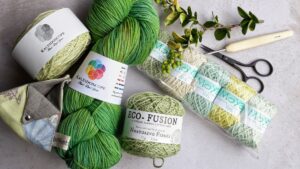Crocheting is a delightful craft, but encountering bleeding colors can be frustrating. Imagine spending hours creating a masterpiece only to see the vibrant hues bleed into each other after washing.
Fear not. With a few precautionary steps, you can ensure your crochet projects remain vibrant and colorfast.
Let’s explore some effective ways to prevent colors from bleeding in your crochet work.
Understanding Color Bleeding
Before diving into prevention methods, let’s understand why colors bleed in crochet projects. Yarns are dyed with vibrant pigments that can release color when exposed to moisture, especially during washing. This bleeding occurs when these loose dye particles transfer from one colored area to another, resulting in a muddled or faded appearance.
Choosing Colorfast Yarns
One of the primary ways to prevent color bleeding starts with the yarn selection. Opt for high-quality, colorfast yarns known for retaining their vibrancy even after washing. Look for yarn labels indicating colorfastness or those that have undergone a colorfastness test.

Test Yarns for Colorfastness
Before starting a project that involves multiple colors, it’s wise to conduct a colorfastness test. Simply dampen a small section of each yarn color and press it against a white cloth. If the color transfers onto the fabric, it’s likely to bleed during washing. Consider using a color fixative or pre-treating the yarn to set the colors before starting your project.
Pre-Washing Yarn
Prevent color bleeding by pre-washing your yarn. Gently hand wash the yarn in cold water using a mild detergent or a yarn-specific cleanser. Rinse until the water runs clear. This step helps remove excess dye that might otherwise bleed onto other colors when your project is complete.
Separating Colors and Blocking
When working with multiple colors in a crochet project, avoid mixing colors that may bleed. Separate colors into different sections or use color-changing techniques that don’t intertwine potentially bleeding shades. After completing your project, consider blocking it. Blocking helps set the stitches and can prevent bleeding by reducing the chances of colors bleeding into one another during future washes.
Proper Washing and Care
Once your crochet masterpiece is complete, it’s essential to wash and care for it properly to maintain its colors. Handwashing in cold water with a gentle detergent is the safest method. Use color catchers or similar products designed to absorb loose dyes during washing. Avoid harsh detergents or excessive agitation, as these can encourage color bleeding.
So,….
Color bleeding in crochet projects can be avoided with a bit of foresight and care. By choosing colorfast yarns, pre-washing, separating colors, and following proper washing techniques, you can preserve the vibrancy and integrity of your crochet creations for years to come. Embrace these preventative measures to ensure that your colorful crochet projects remain as stunning as the day you finished them.
External Resource Links:
- Understanding Colorfastness in Yarn
- Techniques for Handwashing Crochet Projects
- Blocking Crochet Projects for Color Preservation
Moving forward
preventing color bleeding not only maintains the beauty of your crochet work but also ensures its longevity.
Color Fixatives and Vinegar Rinse
Consider using color fixatives or vinegar rinses to set colors in your crochet work. Color fixatives are specially designed products that help lock in dyes, preventing bleeding. Follow the manufacturer’s instructions for application.
Alternatively, a vinegar rinse can also help set colors. Mix one part vinegar with four parts cold water and soak your finished crochet project for 30 minutes. Rinse gently with cold water afterward to remove any vinegar residue.
Avoid Heat and Direct Sunlight
Exposing your crochet projects to high temperatures, such as hot water or direct sunlight, can cause colors to bleed. Always use cold water for washing and avoid leaving your crochet items in direct sunlight for extended periods, as UV rays can fade colors and potentially lead to bleeding.
Retest Colors Periodically
Even colorfast yarns can lose their colorfastness over time or with multiple washes. To ensure ongoing color protection, periodically retest your yarns for colorfastness before starting new projects or washing completed ones.
Store Carefully
Proper storage can also help prevent color bleeding. Store your crochet items in a cool, dry place away from direct sunlight. Avoid overcrowding items, as friction between pieces can cause color transfer.
Conclusion: Embrace Color Protection
By incorporating these strategies into your crochet routine, you’re not just preventing color bleeding; you’re safeguarding the visual appeal and quality of your creations. Choose your yarn wisely, take precautions during washing, and follow proper care guidelines to ensure your colorful projects stay vibrant and beautiful for years to come.
Remember, the key lies in selecting quality yarn, taking preventive measures, and handling your crochet projects with care. With these steps, you can enjoy your colorful crocheting endeavors worry-free!
External Resource Links:
Comparison tabular
Here’s a comparison table summarizing the key methods for preventing color bleeding in crochet projects:
| Prevention Method | Description |
|---|---|
| Choose Colorfast Yarn | Opt for high-quality, colorfast yarns that retain vibrancy even after washing. |
| Test Yarns for Colorfastness | Conduct a colorfastness test before starting a project to check for potential bleeding. |
| Pre-Wash Yarn | Gently hand wash yarn before use to remove excess dye that may bleed during the project. |
| Separate Colors and Blocking | Keep potentially bleeding colors separate or use blocking techniques to prevent color transfer. |
| Proper Washing and Care | Handwash in cold water with gentle detergent, using color catchers to absorb loose dyes. |
| Color Fixatives and Vinegar Rinse | Use fixatives or vinegar rinses to set colors and prevent bleeding. |
| Avoid Heat and Sunlight | Wash in cold water, avoid hot water or direct sunlight exposure that may cause colors to bleed. |
| Retest Colors Periodically | Periodically check yarns for colorfastness to ensure ongoing color protection. |
| Store Carefully | Store crochet items in a cool, dry place away from direct sunlight, preventing potential color transfer. |
Remember, employing a combination of these methods can significantly reduce the risk of color bleeding in your crochet projects, ensuring your creations stay vibrant and beautiful for years to come.
Wrapping up
In the colorful world of crochet, preserving the vibrancy of your creations is key to their enduring beauty. By embracing these methods to prevent color bleeding, you’re not just safeguarding the hues; you’re protecting the essence of your artistry.
Choosing quality yarn, conducting colorfastness tests, gentle pre-washing, meticulous color separation, and mindful care during washing and storage are the threads that weave together to preserve your crochet masterpieces.
So, as you embark on your next crochet journey, armed with these strategies, immerse yourself in the joy of creation without worrying about colors bleeding away. Let your imagination flow, your stitches dance, and your colors shine bright!
Happy crocheting, and may your creations be as vibrant as your creativity!

For over a decade, I’ve been Mike, an artist, crafter, and designer deeply immersed in the Croc world. I thrive on crafting unique, size-inclusive patterns, fostering creativity, and sharing them on ktforum.com. My designs aim to ignite your creative spark and delight you, ensuring clarity and ease of use through rigorous testing. Join me in expressing your creative flair and showcasing your craft with joy.
Related Posts
- Mastering Color Changes in Crochet: A Comprehensive Guide
Crochet is an incredible craft that allows you to create beautiful, intricate designs using yarn…
- Understanding the Risks of Color Bleeding with Varied Dye Setting Times
Color bleeding can be a major headache, especially when it comes to dyeing fabrics. It's…
- Mastering Color Blending on Cinder Block Walls: Techniques and Tips
Bringing life and vibrancy to a cinder block wall through color blending requires technique and…
- Preventing Fabric Bleeding in Your Quilt: A Comprehensive Guide
Quilting is a cherished craft, but the fear of fabric bleeding can dampen the joy…

